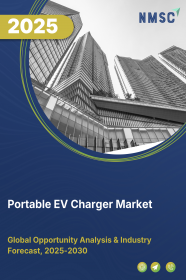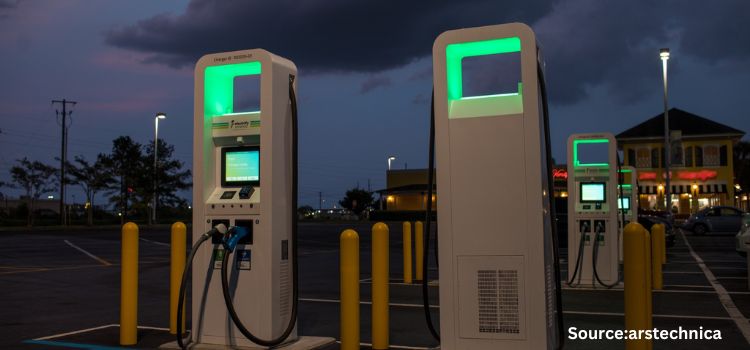
China Electric Vehicle (EV) Charging Market By Type of Charger (AC Chargers and DC Chargers), By Charging Speed (Level 1, Level 2, and Level 3), By Connector Type (J1772 (Type 1),Mennekes (Type 2), CCS (Combined Charging System), CHAdeMO and Others), By Charging Modes (Mode 1, Mode 2, Mode 3 and Mode 4), By Installation (Fixed and Portable), and By End User (Commercial, and Residential) – Opportunity Analysis and Industry Forecast 2023–2030
Industry: Automotive & Transportation | Publish Date: 27-Dec-2024 | No of Pages: 153 | No. of Tables: 116 | No. of Figures: 61 | Format: PDF | Report Code : AT865
US Tariff Impact on China Electric Vehicle (EV) Charging Market
Trump Tariffs Are Reshaping Global Business
Market Definition
China Electric Vehicle (EV) Charging Market was valued at USD 9.98 billion in 2022, and is predicted to reach USD 61.35 billion by 2030, with a CAGR of 26.2% from 2023 to 2030. Electric vehicle chargers are characterized by the rate at which they deliver energy to the vehicle's battery. They serve as a vital infrastructure connecting plug-in electric vehicles to electrical outlets for the purpose of recharging the vehicle's battery. These chargers facilitate the charging process by supplying the necessary electrical energy to the EV's battery.
Charging stations are compatible with electric vehicles, neighborhood electric vehicles (NEVs), and plug-in hybrids, allowing them to connect to an electrical source for charging. Some charging stations come equipped with advanced functionalities such as smart meters, cellular connectivity, and network access.
The charging of EVs can be carried out through several levels of charging such as level 1, level 2, and level 3. The higher the level of charging, the faster the charging process causing more power to be delivered to the vehicle. The use of electric vehicles significantly reduces the carbon footprints released into the atmosphere, which contain toxic gas. The growing threat of carbon emissions and other harmful gases stemming from transportation has triggered the vital necessity of adopting electric vehicles.
In addition, the penetration of EV charging is high in commercial spaces as compared to residential ones. Long-distance trips would benefit from ultra-fast charging capabilities made possible by public charging infrastructure. However, EV chargers for residential spaces offer significant growth potential as they are affordable and more convenient for charging electric vehicles as compared to commercial charging stations.
Government Initiatives Promoting EV Adoption and Charging Infrastructure Set to Fuel EV Charging Market Growth
Increasing government initiatives to promote EV adoption and expand charging infrastructure nationwide are expected to be significant drivers of the EV charging market. These efforts aim to encourage the widespread use of electric vehicles and ensure convenient access to charging facilities across the country, creating favorable conditions for the growth of the EV charging market.
For instance, in January 2022, China announced plans to expand its charging infrastructure to accommodate the country's growing fleet of electric vehicles. 60% of the country's expressway system would be equipped with fast charging stations. China has stated that by the end of 2025, the country will have a demand for 20 million electric vehicles.
Innovative EV Charging Manufacturers and Expanding Business Operations Drive Market Growth
The presence of various EV charging manufacturers that offer innovative, smart charging facilities and business expansion drives the growth of the market. For instance, in February 2022, Tesla announced to build off a second EV facility in China to help it keep up with increasing demand both locally and in export markets. The company plans to increase capacity in China to at least 1 million cars per year, with a second plant planned near its present production in Shanghai's Lingangfree trade zone.
Moreover, in March 2022, Zeekr’s EV charging stations launched in 20 Chinese cities. The company stated that in the first two months of this year, one ‘Zeekr center’ 12 showing spaces, four delivery centers, and 38 self-built charging stations with 12,500 third-party charging piles were established. By the end of this year, there will be more than 300 stores nationwide, allowing the firm to reach more users.
Fast Chargers' High Initial Setup Costs Hinder the EV Charging Market Growth
The growth of the EV charging sector may encounter challenges due to the lack of incentives and concerns regarding high installation costs. A major hindrance to expanding this industry is the substantial initial expense associated with level 3 and ultra-fast chargers. While level 1 and level 2 chargers can take anywhere from 6 to 16 hours for a full charge, consumers are accustomed to refuelling their conventional fossil fuel vehicles in just 5 to 7 minutes.
This has created a strong market demand for fast chargers capable of recharging EVs in under 30 minutes. However, the upfront costs for level 3 charging stations might discourage those considering the transition to EVs, especially because the longer charging times could disrupt their already busy schedules.
Surging Adoption of Vehicle-to-Grid (V2G) EV Charging Stations in China Unlocks Promising Opportunities
Vehicle-to-grid (V2G) EV charging is a technology enabling two-way electrical energy exchange between plug-in electric vehicles (EVs) and the power grid. Thanks to V2G, EVs can store excess electricity and return it to the grid, enhancing the functionality of these electrical components and increasing value for EV owners.
The development of V2G technology has simplified EV charging, making electric vehicles a preferred mode of transportation. Consequently, the entire market for charging stations plays a crucial role in connecting EVs to the grid and facilitating the charging process.
Enel Energia S.p.A. recently installed two V2G EV charging stations at the Italian Institute of Technology's Genoa headquarters as part of the MOV-E project, sponsored by Nissan. The Italian Institute of Technology received two battery electric vehicles (LEAF models) from Nissan, along with the Glide app management platform. This partnership between Enel and Nissan signifies a shift in the way technology is leveraged for sustainable transportation.
As a result, manufacturers have a great chance with the V2G charging technology because it is predicted to change the EV industry and determine how EVs will be charged in the future. Although V2G infrastructure is more beneficial than smart charging, installing V2G charging stations has a hefty up-front cost. Manufacturers of EV connectors are projected to have opportunities to produce sophisticated connectors to withstand electrical architecture due to the predictable and anticipated expansion of V2G technology.
Competitive Landscape
The China Electric Vehicle (EV) Charging industry includes Tesla Inc., BP PLC (Pulse), ABB Ltd., Shell Plc, NaaS Technology, BYD Company Limited, WallBox Inc., Evcstar, Schneider Electric, Siemens, Shenzhen UUGreenPower Co., Ltd., Schargenet, EVB, GreenC and Sino Energy Technology.
Key Benefits
-
The China Electric Vehicle (EV) Charging market report provides a quantitative analysis of the current market and estimations through 2023-2030 that assists in identifying the prevailing market opportunities to capitalize on.
-
The study comprises a deep dive analysis of the market trend including the current and future trends for depicting the prevalent investment pockets in the market.
-
The information related to key drivers, restraints, and opportunities and their impact on the market is provided in the report.
-
The competitive analysis of the market players along with their market share in the China Electric Vehicle (EV) Charging market.
-
The SWOT analysis and Porter’s Five Forces model are elaborated in the study.
-
Value chain analysis in the market study provides a clear picture of the stakeholders’ roles.
China Electric Vehicle (EV) Charging Market Key Segments
By Type of Charger
-
AC Chargers
-
DC Chargers
By Charging Speed
-
Level 1
-
Level 2
-
Level 3
By Connector Type
-
J1772 (Type 1)
-
Mennekes (Type 2)
-
CCS (Combined Charging System)
-
CHAdeMO
-
Others
By Charging Modes
-
Mode 1
-
Mode 2
-
Mode 3
-
Mode 4
By Installation
-
Fixed
-
Portable
By End User
-
Commercial
-
Commercial Public EV Charging Stations
-
Highway Charging Stations
-
Fleet Charging Stations
-
Workplace Charging Stations
-
-
Commercial Private EV Charging Stations
-
-
Residential
Key Players
-
Tesla Inc.
-
BP PLC (Pulse)
-
ABB Ltd.
-
Shell Plc
-
NaaS Technology
-
BYD Company Limited
-
WallBox Inc.
-
Evcstar
-
Schneider Electric
-
Siemens
-
Shenzhen UUGreenPower Co., Ltd.
-
Schargenet
-
EVB
-
GreenC
-
Sino Energy Technology
REPORT SCOPE AND SEGMENTATION:
|
Parameters |
Details |
|
Market Size in 2022 |
USD 9.98 billion |
|
Market Volume in 2022 |
105 Thousand Units |
|
Revenue Forecast in 2030 |
USD 61.35 billion |
|
Growth Rate |
CAGR of 26.2% from 2023 to 2030 |
|
Analysis Period |
2022–2030 |
|
Base Year Considered |
2022 |
|
Forecast Period |
2023–2030 |
|
Market Size Estimation |
Billion (USD) |
|
Growth Factors |
The increasing government initiatives. The presence of various EV charging manufacturers. |
|
Companies Profiled |
10 |
|
Market Share |
Available for 10 companies |
|
Customization Scope |
Free customization (equivalent up to 80 working hours of analysts) after purchase. Addition or alteration to country, regional, and segment scope. |
|
Pricing and Purchase Options |
Avail customized purchase options to meet your exact research needs. |

















 Speak to Our Analyst
Speak to Our Analyst





















